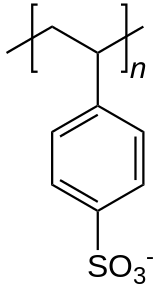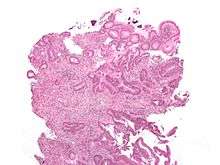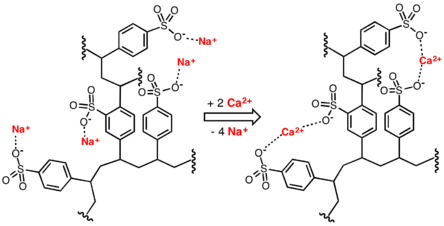Polystyrene sulfonate
Polystyrene sulfonates are a group of medications used to treat high blood potassium.[1] Effects generally take hours to days.[1] They are also used to remove potassium, calcium, and sodium from solutions in technical applications.
 | |
| Clinical data | |
|---|---|
| Trade names | Sodium salt: Kayexalate, Kionex, Resonium A Calcium salt: Calcium Resonium, Sorbisterit, Resikali Potassium and sodium salt: Tolevamer |
| AHFS/Drugs.com | Monograph |
| MedlinePlus | a682108 |
| Pregnancy category |
|
| Routes of administration | By mouth, retention enema |
| ATC code | |
| Legal status | |
| Legal status |
|
| Pharmacokinetic data | |
| Bioavailability | None |
| Metabolism | None |
| Excretion | Faeces (100%) |
| Identifiers | |
| |
| CAS Number | |
| PubChem CID | |
| DrugBank | |
| ChemSpider |
|
| UNII | |
| KEGG | |
| CompTox Dashboard (EPA) | |
| Chemical and physical data | |
| Formula | [C8H7SO3−] n |
| | |
Common side effects include loss of appetite, gastrointestinal upset, constipation, and low blood calcium.[1] These polymers are derived from polystyrene by the addition of sulfonate functional groups.
Sodium polystyrene sulfonate was approved for medical use in the United States in 1958.[1] A single dose in the United States costs about $US13.50 while 30 doses cost about $US64.00 as of 2019.[2]
Medical uses

Polystyrene sulfonate is usually supplied in either the sodium or calcium form. It is used as a potassium binder in acute and chronic kidney disease for people with hyperkalemia (abnormal high blood serum potassium levels).[3] However, it is unclear if it is beneficial and there is concern about possible side effects when it is combined with sorbitol.[4]
Polystyrene sulfonates are given by mouth with a meal or rectally by retention enema.[5]
Side effects
Intestinal disturbances are common, including loss of appetite, nausea, vomiting, and constipation. In rare cases, it has been associated with colonic necrosis.[6] Changes in electrolyte blood levels such as hypomagnesemia, hypocalcemia, and hypokalemia may occur.[7] Polystyrene sulfonates should not be used in people with obstructive bowel disease and in newborns with reduced gut motility.[8]
Intestinal injury
A total of 58 cases of intestinal injury including necrosis of the colon have been reported with polystyrene sulfonate as of 2013.[9] Well more cases have been reported when used in combination with sorbitol and other cases have occurred when used alone.[9]
Interactions
Polystyrene sulfonates can bind to various drugs within the digestive tract and thus lower their absorption and effectiveness. Common examples include lithium, thyroxine, and digitalis. In September 2017, the FDA recommended separating the dosing of polystyrene sulfonate from any other oral medications by at least three hours to avoid any potential interactions.[10]
Mechanism of action
Hyperkalemia
Polystyrene sulfonates release sodium or calcium ions in the stomach in exchange for hydrogen ions. When the resin reaches the large intestine the hydrogen ions are exchanged for free potassium ions; the resin is then eliminated in the feces. The net effect is lowering the amount of potassium available for absorption into the blood and increasing the amount that is excreted via the feces. The effect is a reduction of potassium levels in the body, at a capacity of 1 mEq of potassium exchanged per 1 g of resin.[8][11]
Production and chemical structure
Polystyrene sulfonic acid, the acid whose salts are the polystyrene sulfonates, has the idealized formula (CH2CHC6H4SO3H)n. The material is prepared by sulfonation of polystyrene:
- (CH2CHC6H5)n + n SO3 → (CH2CHC6H4SO3H)n
Several methods exist for this conversion, which can lead to varying degree of sulfonation. Usually the polystyrene is crosslinked, which keeps the polymer from dissolving. Since the sulfonic acid group (SO3H) is strongly acidic, this polymer neutralizes bases. In this way, various salts of the polymer can be prepared, leading to sodium, calcium, and other salts:
- (CH2CHC6H4SO3H)n + n NaOH → (CH2CHC6H4SO3Na)n + n H2O
These ion-containing polymers are called ionomers.
Alternative sulfonation methods
Double substitutions of the phenyl rings are known to occur, even with conversions well below 100%. Crosslinking reactions are also found, where condensation of two sulfonic acid groups yields a sulfonyl crosslink. On the other hand, the use of milder conditions such as acetyl sulfate leads to incomplete sulfonation. Recently, the atom transfer radical polymerization (ATRP) of protected styrene sulfonates has been reported,[12][13] leading to well defined linear polymers, as well as more complicated molecular architectures.[14]
History
Termination of development
Tolevamer was designed to bind the enterotoxins of Clostridium difficile. Since it has no antibiotic properties, it does not harm the gut flora. Early studies used the sodium salt, but it was soon replaced with the potassium sodium salt to prevent hypokalaemia, which is often associated with diarrhea.[15][16]
In early 2008, a noninferiority study versus vancomycin or metronidazole for Clostridium difficile associated diarrhea (CDAD) found that about half of the patients in the tolevamer group did not complete the treatment, versus 25% in the vancomycin and 29% in the metronidazole groups. CDAD recurrence in patients reaching clinical success was reduced significantly by tolevamer (6% recurrence rate), vancomycin (18%) and metronidazole (19%). However, the good result of tolevamer is partly due to the high drop-out rate in this group. Since tolevamer did not reach its primary endpoint in this study, its development was halted.[17]
Chemical uses
Polystyrene sulfonates are useful because of their ion exchange properties.[18] Linear ionic polymers are generally water-soluble, whereas cross-linked materials (called resins) do not dissolve in water. These polymers are classified as polysalts and ionomers.[18]
Water softening
Water softening is achieved by percolating hard water through a bed of the sodium form of cross-linked polystyrene sulfonate. The hard ions such as calcium (Ca2+) and magnesium (Mg2+) adhere to the sulfonate groups, displacing sodium ions. The resulting solution of sodium ions is softened.

Other uses
Sodium polystyrene sulfonate is used as a superplastifier in cement, as a dye improving agent for cotton, and as proton exchange membranes in fuel cell applications. In its acid form, the resin is used as a solid acid catalyst in organic synthesis.[19]
References
- "Sodium Polystyrene Sulfonate Monograph for Professionals". Drugs.com. Retrieved 25 October 2019.
- "Sodium polystyrene sulfonate Prices, Coupons & Patient Assistance Programs". Drugs.com. Retrieved 25 October 2019.
- MedlinePlus Encyclopedia: High potassium level
- Sterns RH, Rojas M, Bernstein P, Chennupati S (May 2010). "Ion-exchange resins for the treatment of hyperkalemia: are they safe and effective?". J. Am. Soc. Nephrol. 21 (5): 733–5. doi:10.1681/ASN.2010010079. PMID 20167700.
- "Polystyrene sulfonate". Martindale: The Complete Drug Reference. Medicines Complete. Retrieved 27 November 2009.
- Rogers FB, Li SC (August 2001). "Acute colonic necrosis associated with sodium polystyrene sulfonate (Kayexalate) enemas in a critically ill patient: case report and review of the literature". J Trauma. 51 (2): 395–7. doi:10.1097/00005373-200108000-00031. PMID 11493807.
- KAYEXALATE (sodium polystyrene sulfonate). FULL PRESCRIBING INFORMATION Revised 07/2017 Retrieved 2018-10-21
- FDA Professional Drug Information for Kayexalate.
- Harel, Z; Harel, S; Shah, PS; Wald, R; Perl, J; Bell, CM (March 2013). "Gastrointestinal adverse events with sodium polystyrene sulfonate (Kayexalate) use: a systematic review". The American Journal of Medicine. 126 (3): 264.e9–24. doi:10.1016/j.amjmed.2012.08.016. PMID 23321430.
- Commissioner, Office of the. "Safety Alerts for Human Medical Products - Kayexalate (sodium polystyrene sulfonate): Drug Safety Communication - FDA Recommends Separating Dosing". www.fda.gov. Retrieved 2017-09-19.
- Chaitman, Martin; Dixit, Deepali; Bridgeman, Mary Barna (January 2016). "Potassium-Binding Agents for the Clinical Management of Hyperkalemia". Pharmacy and Therapeutics. 41 (1): 43–50. ISSN 1052-1372. PMC 4699486. PMID 26765867.
- Sikkema, FD; Comellas-Aragonès, M; Fokkink, RG; Verduin, BJ; Cornelissen, JJ; Nolte, RJ (2007). "Monodisperse polymer-virus hybrid nanoparticles". Organic & Biomolecular Chemistry. 5 (1): 54–7. doi:10.1039/b613890j. PMID 17164905.
- Lienkamp, Karen; Schnell, Ingo; Groehn, Franziska; Wegner, Gerhard (2006). "Polymerization of Styrene Sulfonate Ethyl Ester by ATRP: Synthesis and Characterization of Macromonomers for Suzuki Polycondensation". Macromolecular Chemistry and Physics. 207 (22): 2066. doi:10.1002/macp.200600322.
- Lienkamp, Karen; Ruthard, Christian; Lieser, GüNter; Berger, RüDiger; Groehn, Franziska; Wegner, Gerhard (2006). "Polymerization of Styrene Sulfonate Ethyl Ester and Styrene Sulfonate Dodecyl Ester by ATRP: Synthesis and Characterization of Polymer Brushes". Macromolecular Chemistry and Physics. 207 (22): 2050. doi:10.1002/macp.200600321.
- H. Spreitzer (September 24, 2007). "Neue Wirkstoffe - Tolevamer". Österreichische Apothekerzeitung (in German) (20/2007): 955.
- Wang, Y, Serradell, N, Rosa, E, Bolos, J (2007). "Tolevamer Potassium Sodium". Drugs of the Future. 32 (6): 501–505. doi:10.1358/dof.2007.032.06.1108513.CS1 maint: multiple names: authors list (link)
- Medscape.com: Tolevamer Less Effective Than Standard Therapies for C difficile–Associated Diarrhea
- François Dardel and Thomas V. Arden "Ion Exchangers" in Ullmann's Encyclopedia of Industrial Chemistry, 2008, Wiley-VCH, Weinheim. doi:10.1002/14356007.a14_393.pub2
- Erik Gálvez, Pedro Romea, and Fèlix Urpí (2009). "Stereoselective Synthesis of anti α-Methyl-β-Methoxy Carboxylic Compounds". Organic Syntheses. 86: 81.CS1 maint: multiple names: authors list (link)